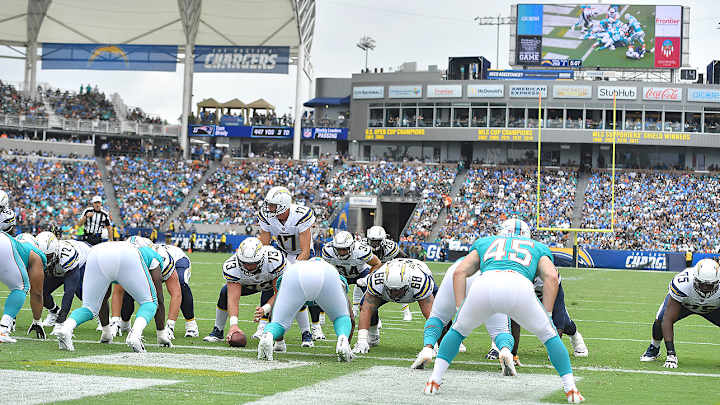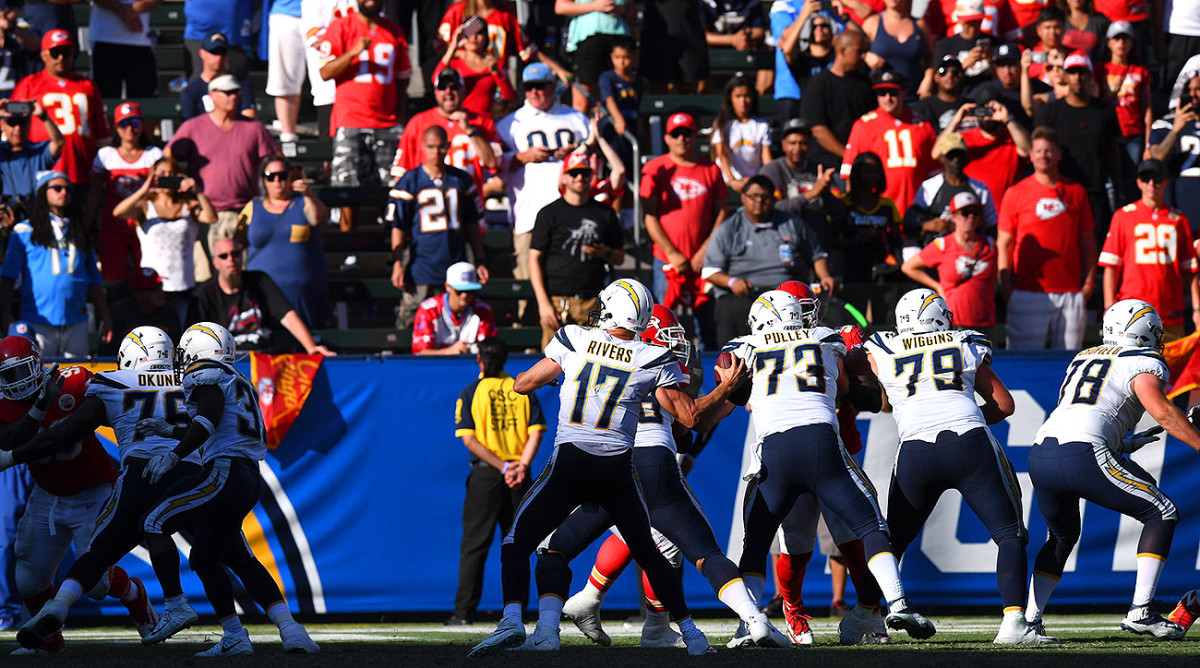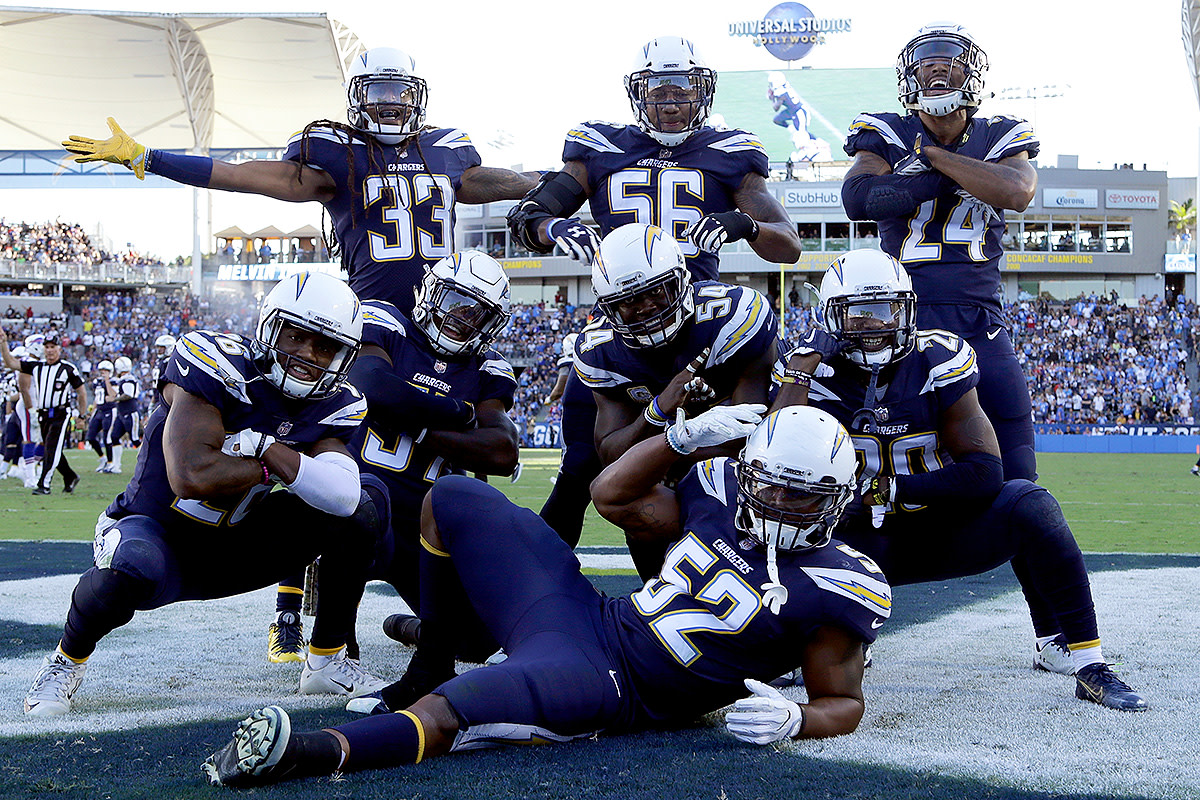Chargers Are Ready to Claim Their Piece of the Los Angeles Sports Market

The 2018 season is shaping up to be the most anticipated year ever for the NFL in California. The MMQB’s Andy Benoit is diving into the storylines for our special offseason project: California Week. Check back regularly for more.
COSTA MESA, Calif. — The Los Angeles Chargers headquarters is located in a nondescript leased office building amidst a white-collar industrial sprawl in Costa Mesa, Calif., about 45 minutes from downtown L.A. The building is located to the left of a circular courtyard. To the right of the courtyard is a vacant building, and straight behind the courtyard is a coffeehouse.
Inside the office building, Chargers owner Dean Spanos is seated at the head of the table in a second-floor conference room. Over his shoulder is a giant rendering of the team’s new stadium, which will be located in Inglewood, just shy of an hour’s drive from the current office. Under construction until 2020, it’s the mecca toward which this franchise is marching.
“It’s incredible—look at that,” Spanos says, turning to face the photo. “I mean, that’s massive. It doesn’t look like a football stadium, does it?”
No, and that’s because, in many ways, it isn’t. The nearly $5-billion venue, formally called Los Angeles Sports and Entertainment District (LASED), will include business parks and condominiums, a 6,000-seat theatre, luxury hotels and restaurants, an open-air shopping center and NFL Media’s nerve center. Rams owner Stan Kroenke is spearheading the project, with the stadium itself a joint venture between the two teams—the Rams and Chargers will operate under equivalent leases, and the Chargers will receive 18.75% of the LASED non-football event revenue.
But underneath all of the hype of the new stadium and the glamour of the Los Angeles area, a hard truth remains: the Chargers are the newest team in a very crowded sports market—11 teams, to be exact. And even if the product on the field is up to snub—and it should be, as this team is a favorite to win the AFC West this year—is that enough for the Chargers to truly carve out its niche in Los Angeles? It will be a challenge, but the Chargers are up for it.

Moving to a new city before your stadium's completion is innately trying. After leaving Houston in 1997, the Oilers, waiting on their downtown Nashville venue, played home games at Liberty Bowl Stadium in Memphis. Attendance was abysmal, and when it wasn’t, opposing fans were extraordinarily prevalent. The next year owner Bud Adams moved games to Vanderbilt—a site he had initially rejected. The Oilers went 8–8 both years.
The Chargers faced similar attendance struggles last season. Playing at the 27,000-seat StubHub Center in Carson, Calif., the team often found that the fans enjoying the intimate atmosphere were actually cheering for L.A.’s opponent. In Week 2 of the 2017 season, Younghoe Koo, the Chargers kicker at the time, missed a field goal at the end of regulation to lose to the visiting Dolphins, and QB Philip Rivers said that missed kick produced the loudest roar of the crowd all day. The following week, the red of the visiting Chiefs’ fans glaringly contrasted with L.A.’s fans' blue.
There are different thoughts in the Chargers office as to what was behind this enemy infiltration.
“Really, when you look at it on a percentage-base, it’s no different than any of the other teams,” Spanos says. “This is not something that is just unique to us. I think the Rams experienced it a bunch last year. Miami experiences it with all the New England fans there. It’s nothing new.”
GM Tom Telesco says it’s always going to be like that for teams in a destination city. “If you live in Buffalo and you’re going to go to one road game this year, [the fan typically thinks] ‘Hey let’s go to L.A. or Miami!’ At Qualcomm Stadium [in San Diego] let’s say we got 10,000 visiting fans. [In a stadium that holds 70,000 people] you notice those fans, but not that much. You get those same 10,000 at StubHub, it looks a lot different.”
Rivers issued similar sentiments following that early loss to Miami last season, saying, “It’s always been a little bit of something you battle. We battled it down in San Diego… the weather, the climate, lends to that.”
But traveling fans aren’t the Chargers’ only problem—finding and growing the team’s own fan base remains an issue. There are around 24 million people in Southern California, including many transplants who may have brought fandom with them, and with no team in town from 1995–2015, many Angelenos have adopted one of the NFL’s 30 non-LA teams as their own.
It didn’t help when, before the season, Los Angeles mayor Eric Garcetti said on the Dan Patrick Show, “We’re certainly happy to have the Chargers in L.A., but I think we could have been happy with just the [Rams] too.” Some in the Chargers’ building believe Garcetti was just trying to appease San Diego and the state’s other non-L.A. markets (rumor has it that he wants to run for governor or even president one day). Spanos believes Garcetti’s comments were misrepresented in the media, and he professes no ill-will.
But after those comments, mixed with opposing fan optics and the team’s heartbreaking 0–4 start to the season, it’s easy to see why the Chargers struggled with a loser narrative last season.
That shouldn’t be the case in 2018; this team is favored to win the AFC West. Head coach Anthony Lynn even recently lamented to The MMQB’s Albert Breer that someone had told him the Chargers had the second-most talented roster in the league. While maybe a tad hyperbolistic, the notion is not ridiculous. Rivers is a bona fide field general, and his receiving corps is loaded, even with tight end Hunter Henry out with a torn ACL. The backfield and offensive line are improving, and the defense has what every team covets: perimeter cover corners (Casey Hayward and, if healthy, Jason Verrett) and dominant edge rushers (Joey Bosa and Melvin Ingram). The interior of the D was addressed in the draft, with safety Derwin James in Round 1, linebacker Uchenna Nwosu in Round 2 and defensive tackle Justin Jones in Round 3.
Best in the AFC West: 10 Thoughts on the 2018 Chargers
Lynn was praised for leading the Chargers to nine wins after entering October under the most difficult of circumstances. Now, nine wins would be disappointing. The rough start last year “just made us a tougher football team,” Lynn says. “We became more resilient. And now last year’s not even in the back of our heads anymore, we’re focused on this season.”
The fascinating question is, Just how much success will it take for the Chargers to move the meter locally?
“Everybody loves a winner up here and we have to put that product on the field,” says Spanos. “It’s a challenging market. We knew it when we came here. There are 11 other teams we’re competing against.”
A quick look at the 11 other teams to which Spanos is referring: The MLB’s Dodgers and Angels, which are both a little above .500, as of publish; the NBA’s Clippers, which just missed the playoffs and the Lakers, which are rebuilding; the NHL’s Ducks and Kings, which reached the Stanley Cup playoffs but were both swept in the first round; MLS’s LAFC, currently third in the Western Conference, and the Galaxy, sitting eighth; USC and UCLA, which both lost their quarterbacks to the first round of the NFL draft; and of course, the Rams—the team with which the Chargers will be sharing a stadium, and their most direct competition. Also, the WNBA’s Sparks currently lead the Western Conference.
Surprise winners of the NFC West in 2017, the Rams have had one of the most unique, aggressive offseasons in recent memory and are now among the early favorites to win Super Bowl 53. They’re slated for five nationally televised games in 2018. And yet they too are still trying to gain a foothold in the L.A. market.
After a record-setting year-over-year decline in attendance last September, the Rams averaged 63,392 in home attendance on the season, which ranked 26th int he league, and filled a league-low two-thirds of their venue (the L.A. Coliseum). Their local TV ratings were 8.0, meaning just eight percent of L.A. televisions were tuned into their games. The Chargers got a 6.0, though it should be noted that a ratings point in Los Angeles represents 5.2 times as many people as a ratings point in San Diego.
Legitimate concerns were raised about the Rams having had the opportunity to secure much of the available L.A. fans simply by arriving to town a year earlier. Spanos says his staff spends little time thinking about the Rams, but he’s rooting for their success.
“If I could line the stars up, it would be great if we—the Rams and Chargers—could play each other in the Super Bowl this year in Atlanta,” he says. “For this market, for sales, it would be exciting. You know, timing could be impeccably perfect. But if we can’t win the Super Bowl, I’d probably say I’d want the Rams to win because it just helps the [stadium] project. We are part of this, we have equity in this, we’re an equal partner in this thing. And I think [Kroenke], if he was sitting here, would say the same thing. We wish each other good luck except when we play each other. The better I do is going to help him and vice versa.”
Though it’d be unimaginable in most markets, with Los Angeles, where fans have so many options for sports, as well as for pop culture entertainment and outdoor activities, one also must wonder what the team does in the event that it makes a deep playoff run but sees little rise in local popularity. Spanos doesn’t like looking away from the big picture. “Our goal every year is to win the Super Bowl … even if we make a deep playoff run this year, it’s about sustained success.”

Success on the field always comes first, but Spanos is a businessman who recognized the opportunities that Los Angeles could bring to his franchise.
“No. 1 is obviously the product on the field—and I can’t control that,” he says. “I can try to hire the best coach, the best GM to bring in the best players but there’s no guarantee on anything. But that’s one part of it. The other part is really how we as an organization, our family, integrate ourselves into this community.”
Spanos meets with small groups three or four times a week, building relationships piece by piece. And from July through December last year the Chargers participated in 150 community events and charitable programs, with an emphasis on causes promoting social justice. They partnered with the city’s most established media outlets and hired the area’s top afternoon drive sports talk radio host, Matt “Money” Smith, as their lead announcer. This year, their “Fight for L.A.” slogan will incorporate a “Fight for Each Other” slogan.
On brand growth, Spanos and his staff proceed as if it comes down to 50% winning and 50% business strategy. And the most obvious move that illustrates that? Hiring Lynn as head coach. Instead of splurging for a big-name head coach to galvanize the fan base, the Chargers’ brass hired one who was well-regarded within the NFL but largely unknown to fans outside the AFC East. Contrast that with the Raiders, who spent $100 million on Super Bowl winning celebrity coach Jon Gruden, perhaps partly with the hope of sustaining the Oakland fan base and, soon, igniting the Las Vegas one.
As John Spanos, President of Football Operations, explains, “At the end of the day, the driving force [behind hiring Lynn] was who will help us win games over who will help initially sell tickets.” When it’s pointed out that Bill Belichick was almost antithetical to a flashy hire in New England, Spanos says, “How ’bout that. He was the head coach of the Browns, got let go and was an assistant again. I don’t remember him at that point being a necessarily flashy guy, so it’s a good point.”
Anthony Lynn Gets his Degree for his Players, for his Family and for Himself
John’s dad has not prioritized a head coach’s marketability, either.
“I think that’s short-lived to go out and hire somebody flashy,” Dean says. “In either 2001 or ’02, I really wanted to hire Jimmy Johnson. We’re pretty good friends and I tried, but he was retired and he didn’t want to come back. That was the only time I really wanted to go after somebody. I believed in him and he was sort of a mentor to me so even that was more than, ‘Oh there’s a name out there, let me go chase him.’ I knew him. But he wanted to fish down in Miami.”
What hangs in the air when talking with anyone from the Chargers is the city of San Diego. Spanos, his family and employees are quick to emphasize how much the city still matters to them. The Chargers have maintained all of their existing community programs in San Diego, and they realize that many fans there are still loyal. But they also realize that many are still hurt. As one staffer put it, emotions remain “too raw” to consider marketing the team to those citizens. Quick as Chargers employees are to laud San Diego, the conversation always quickly shifts back slightly north.
The obstacles may seem insurmountable for this Los Angeles team, but it’s nothing the team isn’t ready to face head-first. This team’s home is now Los Angeles.
“To go where we want to go it might take ten years,” Spanos says. “We are the new kids on the block so, you know, we are fighting our way in one fan at a time. But whatever it is, we’ll get there.”
Question or comment? Email us at talkback@themmqb.com.
